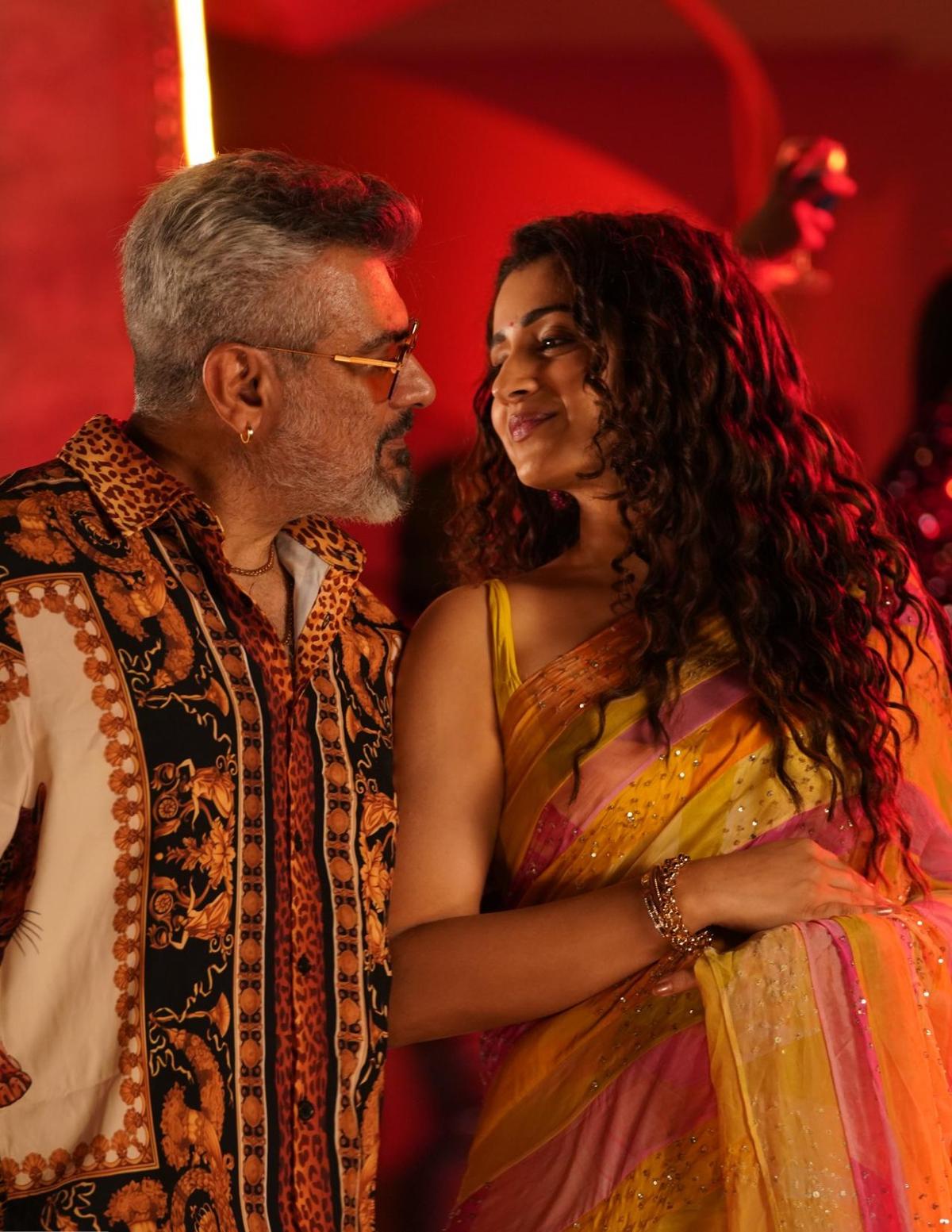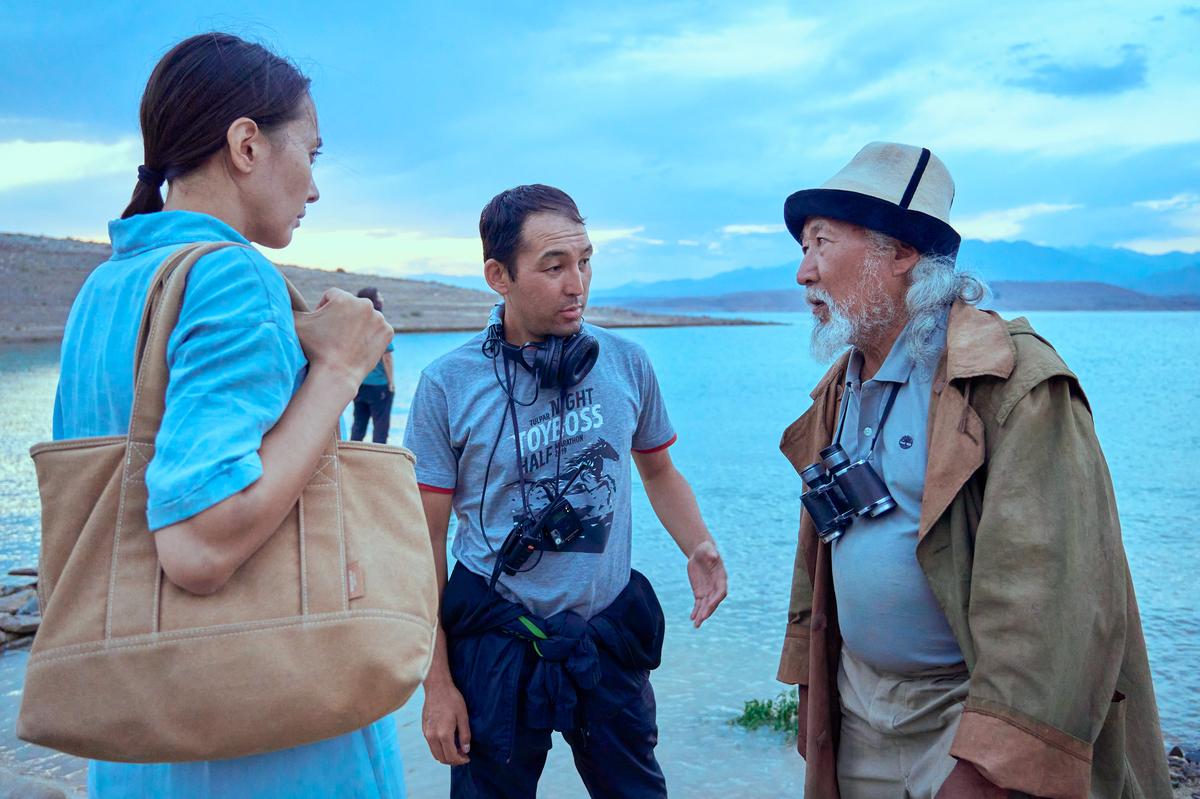Who knew that a character sending a specific someone’s photo on a WhatsApp group would make for one of the ‘massiest’ sequences we have seen in recent times? Director Adhik Ravichandran, who, over the last ten years, has gotten us used to his use of bright colours, dutch-angle shots and quirky humour, takes it up a notch with his fifth film Good Bad Ugly (GBU), and with his idol Ajith Kumar headlining it, the young filmmaker pulls off what netizens would term as a “fanboy sambavam.”
In GBU, AK (Ajith Kumar) is a retired gangster who has spent his due share of time behind bars and wants to lead a happy life with his wife, Ramya (Trisha), and son, Vihaan (Karthikeya Dev). But trouble comes knocking his way when his son is wrongly arrested and put behind bars. For the sake of the very son for whom he put down arms, AK now has to enter a world he vowed never to return to.
Mark Antony will remain unchallenged as Adhik’s most complex film yet as he goes back to his roots to conjure a wafer-thin plot for GBU. So what does he fill up the film with? There’s Ajith to save the day, and when he isn’t walking or talking, we have a slew of characters that mouth references to the actor’s yesteryear films. These references are stuffed to the brim in Good Bad Ugly. If nothing else, it makes for a great drinking game: if you took a shot each time an Ajith film reference is made, you would be out cold before it’s intermission.
To run with the Gen-Zoomers, I would call GBU a ‘vibe.’ You would either find it to be your cup of soothing tea or an ostentatiously made smoothie of mindless reel-worthy sequences stitched together. The film certainly takes time to get going, and if you are like me, it does grow on you and might even leave you wondering if it actually gets better when it picks pace or whether you have gotten used to this world that Adhik has elaborately crafted. No wonder he starts the film with a card that goes ‘Welcome to the world of GBU’ and he is not kidding with it. In this world, logic does not take the back seat; it’s tied to the back of the car and dragged for miles only to realise that the rope snapped a long time ago. If you are familiar with Adhik’s work, logic and emotionality would be the last things you would expect to find here.
Good Bad Ugly (Tamil)
Director: Adhik Ravichandran
Cast: Ajith Kumar, Trisha Krishnan, Arjun Das, Prasanna, Karthikeya Dev, Priya Prakash Varrier
Runtime: 140 minutes
Storyline: A retired gangster is forced to take up arms one last time to save his son
And if you are not familiar with Ajith’s body of work, GBU isn’t for you. The references to his previous films start right from the very first scene, which includes a voiceover by Mahanadhi Shankar, the man whose dialogue in Dheena gave Ajith the nickname ‘Thala.’ Of course, as expected, there are references to other hits such as Billa, Varalaru, Mankatha, Villain, Amarkalam and Vaalee. What comes as a pleasant surprise are the references to relatively lesser-known titles like Red and Kireedam. In fact, it’s not just Ajith who gets this treatment. Simran, who appears in a cameo as Priya from Vaalee, talks to AK about his ‘Sona’ (IFKYK). Trisha supples a Lesa Lesa callback, Prabhu repeats a line he once mouthed in Billa, Prasanna gets a Sneha reference… the list keeps going. There’s even a Vijay reference!
Just as you wonder if Adhik is relying solely on these callbacks, he brings the best of Tamil pop culture to the screen — right from the trending meme jokes such as the ‘Irunga bhai’ line and the ‘card mela irrukura 16 number’ joke to remixing the iconic ‘Puli Puli’ song by Darkkey Nagaraja (apart from crooning the song, the Samba Rock icon makes a cameo too). Speaking of yesteryear songs, if Adhik hadn’t warned you with the ‘Panju Mittai’ remix in Mark Antony, we get everything from a remix of ‘Oththa Roova’ from Nattupura Pattu, a sampling of ‘En Jodi’ from Vikram and usage of ‘Sakalakala Vallavan’ and ‘Thottu Thottu Pesum’ tracks.

Arguably, the biggest trick Adhik pulls off is how he stacks easter eggs and references to hide the utter lack of an intriguing plot. Nevertheless, cracks appear multiple times in the facade that he has carefully sculpted. The secondary characters rarely have anything to do besides praising AK, and with even Arjun Das’s The Prestige-inspired villain failing to intimidate, GBU suffers without a fascinating conflict. At its core, GBU is the story of a gangster husband and a government official wife who use their brawn and brain to save their son from being wrongfully punished by the law. However, the film never builds on this. Instead, it becomes a showreel by a fanboy who has gotten to work with his favourite star — which, surprisingly, works in places. What comes as a pleasant shocker are the references to international titles, which, we hope, do not land the team in troubled waters over IP issues.

Ajith Kumar and Trisha in a still from ‘Good Bad Ugly’
| Photo Credit:
Special Arrangement
With an awfully predictable story that leaves very little room for plot twists or surprises, GBU banks on its star and his unabashed, unhinged persona that fans have missed for years, making it an entertaining watch. From ‘Thala’ references to letting the supporting cast sing praise of how he’s the Red Dragon, Ajith lets his hair down. To see him shake a leg or pull off quirky lines like ‘bank ah, mottai ah’, is unarguably a treat, especially for his fans who had very little to enjoy in his other recent films. Even if we discount the annoying one-liners (one goes, “I am not Frank, it’s just a prank”), it’s ultimately his dialogues with which Adhik blurs the line between reality and fiction, a personal favourite being one on how AK disbanded the clubs while he was an active gangster.
In his most technically strong film to date, Adhik’s team behind the camera have done a brilliant job. While Abinandhan Ramanujam’s camera work wonderfully captures the gigantic yet intricate sets and vast outdoors of Spain and Mumbai, editor Vijay Velukutty does the hard job of putting together a series of sequences with jarring tonal jumps. Anu Vardhan’s costumes deserve special praise for making AK look dapper, irrespective of whether he’s dressed in an uber-cool Versace silk shirt or a sleek three-piece suit. GV Prakash’s songs might not have hit the bullseye, but his background score amps up the star vehicle.
Considering how there’s a scene where AK breaks the fourth wall and has a conversation with the director, we will probably never get used to the rules of this ‘world.’ Even when his films like AAA and Bagheera missed the mark by miles, Adhik’s strong suit has always been his cinematic language and use of nostalgia, which he majorly banks on for GBU. The minor examples of a car number plate being his jumbled name or going with a crazy casting choice — such as roping in Usha Uthup for the role of a judge — stand testimony to his wacky ideas, which do wonders when they work, making you wish there were more laced between the umpteen references.
That the film’s title is a hat-tip to the legendary The Good, the Bad and the Ugly reminds one of the famous line from the Sergio Leone directorial, “When You Have To Shoot, Shoot. Don’t Talk”. Adhik has taken his biggest shot, and it could possibly be the best fan service Tamil cinema has ever seen. Even when it’s far from perfect and feels like a brass-knuckle punch to our senses, Good Bad Ugly is loving work of nostalgia.
Good Bad Ugly is currently running in theatres
Published – April 10, 2025 07:38 pm IST








































